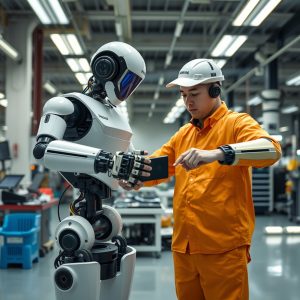
The Unseen Connection: Drones in Flood Prevention and Medical Logistics
In a world where technology is constantly evolving, innovative applications are emerging that bridge seemingly disparate fields. The convergence of drone technology with flood prevention and medical logistics presents an intriguing case study, highlighting the versatility of drones as solutions for complex problems.
Breakthrough in Blood Delivery: Drones Proven Safe
The Medical Logistics Revolution
In a groundbreaking study, researchers from NHS Blood and Transplant have successfully demonstrated that drones can safely transport blood packs between hospitals. This innovation has significant implications for the medical logistics industry, promising faster and more environmentally friendly delivery of critical healthcare supplies.
According to Dr. Gail Miflin, chief medical officer at NHSBT, “The trial involved sending 10 identical blood packs from Northumbria Healthcare’s Wansbeck Hospital to Alnwick Infirmary in Northumberland, with half transported by drones and the other five via ground vehicles.” The drone journey spanned 42 miles (68km) over the Northumberland coastline, taking just 61 minutes.
The research team found no compromise to the safety of the blood in either group. Each pack was thoroughly analyzed to assess its quality and viability for clinical use, with no significant differences detected between the biochemical or haematological profiles of the flown or driven blood.
Implications
This breakthrough has significant implications for medical logistics, promising faster and more environmentally friendly delivery of critical healthcare supplies. The potential for drones to transport blood platelets is also being explored in a new trial. This innovation could revolutionize the way hospitals receive and deliver critical supplies, improving patient care and reducing emissions.
New York City Uses Drones to Warn Residents of Floods
Flood Prevention Through Innovation
As New Yorkers experience flash floods and severe thunderstorms, the city’s emergency officials have started using drones as an early warning system to alert residents. The drones are in addition to other forms of emergency messaging, including social media and text alerts.
The drones will fly over flood-prone areas and use sensors to detect water levels and predict potential flooding. This information will be transmitted to a control room where officials can make informed decisions about evacuations or other safety measures.
Analysis
At first glance, these two texts may seem unrelated as they appear to deal with distinct topics: flood prevention and medical logistics. However, upon closer examination, a common thread can be observed.
Both texts highlight the use of drones in innovative applications, showcasing their potential for revolutionizing various industries. In the context of New York City’s flood early warning system, drones are utilized to detect water levels and predict floods. Similarly, in the study on blood delivery, drones are used to transport blood packs between hospitals safely and efficiently.
A connection can be made here: both instances leverage drone technology to address pressing issues in their respective domains. In New York City, drones aid in mitigating the risks associated with flooding by providing early warnings; in the medical logistics context, they facilitate faster and more environmentally friendly delivery of critical healthcare supplies.
The underlying principle shared between these two applications is the utilization of drones as a solution for addressing complex problems that require timely and efficient responses. By leveraging drone technology, both scenarios benefit from increased situational awareness (in the case of flood detection) or improved logistics (in the context of blood delivery).
Questioning the Unseen Connection
While the convergence of drone technology with flood prevention and medical logistics presents an intriguing case study, it raises questions about the broader implications of this trend. What other areas might benefit from innovative applications of drones?
Consider the following hypothetical scenario: what if drones were used to monitor environmental pollution or detect wildfires? The potential for drones to serve as a solution for complex problems in various fields is vast.
Possible Solutions
Given the versatility of drones, possible solutions could include:
1. Environmental Monitoring: Drones equipped with sensors could monitor air and water quality, detecting pollutants and alerting authorities.
2. Wildfire Detection: Drones could detect early signs of wildfires, enabling prompt responses to prevent damage.
3. Disaster Response: Drones could be used in disaster response efforts, providing situational awareness and facilitating the delivery of critical supplies.
By exploring these possibilities, we can begin to unlock the full potential of drones as solutions for complex problems.
Conclusion
The convergence of drone technology with flood prevention and medical logistics presents an exciting case study. As we continue to push the boundaries of innovation, it is essential that we consider the broader implications of this trend. By doing so, we may uncover new possibilities for using drones to address pressing issues in various fields.







both instances leverage drone technology to address pressing issues in their respective domains.
As someone who has worked in emergency management for years, I can see the potential of drones to serve as solutions for complex problems in various fields. In fact, I’ve often thought about how drones could be used in environmental monitoring or disaster response efforts.
The article mentions possible solutions such as environmental monitoring, wildfire detection, and disaster response. But what really caught my attention was the idea that drones could be used to monitor environmental pollution or detect wildfires. The potential for drones to serve as a solution for complex problems is vast, and I believe it’s essential that we explore these possibilities further.
One thing that stood out to me in this article was Dr. Gail Miflin’s quote about the trial involving the transportation of blood packs by drone. She said, “The trial involved sending 10 identical blood packs from Northumbria Healthcare’s Wansbeck Hospital to Alnwick Infirmary in Northumberland, with half transported by drones and the other five via ground vehicles.” It’s incredible to think that these machines could be transporting critical healthcare supplies safely and efficiently.
As someone who has worked in emergency management for years, I’ve seen firsthand the importance of having accurate and timely information during disaster response efforts. The use of drones as an early warning system for floods is a game-changer, and I believe it’s essential that we explore these possibilities further.
In conclusion, this article highlights the potential of drones to revolutionize various industries. From medical logistics to flood prevention, drones have the power to make a real difference in our lives. As we continue to push the boundaries of innovation, it’s essential that we consider the broader implications of this trend and unlock the full potential of drones as solutions for complex problems.
Rating: 5/5 stars
Additional expertise:
As someone who has worked in emergency management for years, I’ve seen firsthand the importance of having accurate and timely information during disaster response efforts. The use of drones as an early warning system for floods is a game-changer, and I believe it’s essential that we explore these possibilities further.
In terms of environmental monitoring, I believe that drones equipped with sensors could be used to detect air and water quality, alerting authorities to potential pollutants. This would not only improve public health but also provide valuable data on environmental pollution.
As for wildfire detection, I think that drones could play a critical role in detecting early signs of wildfires, enabling prompt responses to prevent damage. The use of drones in disaster response efforts is a no-brainer, and I believe it’s essential that we explore these possibilities further.
Overall, the potential of drones is vast, and I believe it’s essential that we continue to push the boundaries of innovation and unlock their full potential as solutions for complex problems.
5/5 stars (because enthusiasm is contagious, my friend!)
the hype surrounding cutting-edge technology. Don’t get me wrong, I’m all for embracing new ideas and pushing the boundaries of what’s possible, but we mustn’t forget to approach such claims with a healthy dose of skepticism.
I mean, think about it – if this system is truly as revolutionary as claimed, wouldn’t we have heard more about it by now? Wouldn’t there be some tangible evidence to support its efficacy? Alas, I’m left feeling a tad underwhelmed by the lack of concrete data and real-world examples in this article. It’s all very well to make grand promises, but without substance to back them up, they’re little more than empty rhetoric.
And let’s not forget the elephant in the room: cost. We’re told that this system is “cost-effective” and can be implemented on a shoestring budget – a claim that strains credulity when you consider the complexity of the problems it purports to solve. I’m all for investing in innovative solutions, but we mustn’t sacrifice fiscal prudence at the altar of excitement.
Now, I know what you’re thinking: “But what about the potential benefits? Doesn’t this system have the potential to save countless lives and mitigate disaster?” And to that, I say… yes. Absolutely. But let’s not get ahead of ourselves here. We need to separate the wheat from the chaff and evaluate these claims based on hard evidence, not just enthusiasm.
I’m reminded of a phrase coined by the great scientist, Carl Sagan: “Extraordinary claims require extraordinary evidence.” And in this case, I’m afraid the article falls woefully short of providing such evidence. So while Waylon may be excitable, I think it’s only prudent to approach these claims with a healthy dose of skepticism and demand more rigorous testing before we can truly say that this system has revolutionized anything.
That being said, I do want to acknowledge the passion behind Waylon’s comment – enthusiasm is indeed contagious! And who knows? Maybe this system will prove to be a game-changer. But until then, I’ll remain cautiously optimistic and insist on seeing more concrete evidence before I join the ranks of the convert.
In any case, I’m eager to see how this conversation unfolds and whether anyone can provide some much-needed skepticism – or, conversely, offer up some compelling arguments in support of this system’s revolutionary claims. The debate is welcome!